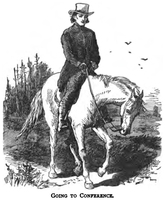 | Back to e-WV
| Back to e-WV
 The West Virginia Encyclopedia
The West Virginia Encyclopedia
 | Back to e-WV
| Back to e-WV
 The West Virginia Encyclopedia
The West Virginia Encyclopedia

Circuit riders were clergymen, usually of the Wesleyan tradition, who rode from one group of believers to another for the conduct of worship and religious instruction. They faced great hardships and rode many miles to carry out their ministry. The result of their work was the creation of strong churches throughout the early American republic, including present West Virginia.
The origins of the circuit rider can be traced to the organizational structure developed by John Wesley, the founder of Methodism. Wesley advocated the creation of ‘‘classes’’ of believers who would meet regularly for worship and Bible study and to support one another in the faith. John Wesley appointed two superintendents in the United States — Francis Asbury being the best known — to ordain clergy and to lead the churches and classes already formed. Usually these ordained clergymen were assigned a number of classes located geographically in a circuit. Depending on the size of the circuit the preacher might visit a class only once or twice a year. Even today in small towns and rural areas it is not unusual for a United Methodist minister to have a circuit of four or five small churches.
Circuit riders were important in the formation of the Methodist and United Brethren traditions in West Virginia. Asbury himself traveled across the state several times and was responsible for founding a number of congregations. Circuit riders came into what is now West Virginia from two directions. The first circuit rider was John Smith from the Holston Conference in Tennessee. He was responsible in 1787 for creating Rehoboth Church, the first Methodist church west of the Alleghenies, near Union in Monroe County. Other riders, including Henry Bascom and Asa Shinn, came south from the Redstone Conference in Pennsylvania. These men created congregations in the northern part of the state, in cities such as Parkersburg, Clarksburg, and Grafton, and in smaller towns and rural areas.
By the early 1800s, the expansion of the two conferences began to overlap in central West Virginia. When Methodists split before the Civil War into northern and southern branches, generally the churches created by the Holston Conference became Southern Methodist and those created by the Redstone Conference remained Methodist Episcopal or Northern Methodist, although there were many exceptions. The result, for example, was the existence of Southern Methodist St. Mark’s in Charleston, several blocks away from Christ Church M.E. This situation was repeated in many cities and towns in West Virginia and was perpetuated until the reunification of both branches of Methodism in 1939.
Written by Robert L. Frey